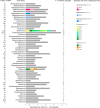Metagenomic detection of central nervous system infections missedby conventional testing
- PMID: 40392601
- PMCID: PMC12306619
- DOI: 10.1172/jci.insight.189295
Metagenomic detection of central nervous system infections missedby conventional testing
Abstract
Community-acquired infectious meningoencephalitis is associated with high rates of mortality and morbidity, compounded by limited access to diagnostic resources. The current study assessed acute central nervous system (CNS) infections in patients with meningoencephalitis enrolled in a hospital-based diagnostic surveillance study in São Paulo, Brazil. Cerebrospinal fluid (CSF) was collected from 600 patients between March 2018 and November 2019 and initially screened for a broad range of pathogens according to a local diagnostic algorithm. Standard microbiological and molecular diagnostic methods were applied. Metagenomic sequencing was used as a complementary approach to investigating etiology in instances where no pathogen was initially identified. Standard testing identified infectious etiologies in 292 patients (48.6%), with 227 (77.7%) confirmed as viral infections, predominantly caused by enteroviruses (n = 144) and herpesviruses (n = 40). Nonviral agents were identified in 65 patients (22.3%). Metagenomic sequencing (mNGS) of 277 of 308 undiagnosed patients revealed several additional potential etiologies, including Parvovirus B19, Toxoplasma gondii, Picobirnavirus, other enterovirus species and Vesivirus, the latter being associated with CNS infection for the first time. These findings underscore the complexity of CNS infections and highlight the potential of metagenomics to improve diagnostic accuracy, inform treatment strategies, and support efforts to address future pandemics.
Keywords: Clinical Research; Infectious disease; Molecular diagnosis.
Conflict of interest statement
Figures




Similar articles
-
The added value of metagenomic next-generation sequencing in central nervous system infections: a systematic review of case reports.Infection. 2025 Jun;53(3):831-849. doi: 10.1007/s15010-025-02502-2. Epub 2025 Mar 13. Infection. 2025. PMID: 40080343 Free PMC article.
-
Clinical Metagenomic Sequencing for Diagnosis of Meningitis and Encephalitis.N Engl J Med. 2019 Jun 13;380(24):2327-2340. doi: 10.1056/NEJMoa1803396. N Engl J Med. 2019. PMID: 31189036 Free PMC article. Clinical Trial.
-
Clinical Application Value of Metagenomic Next-Generation Sequencing at Perioperative Period in Patients with Central Nervous System Infections in Neurosurgical Intensive Care Unit.World Neurosurg. 2025 Apr;196:123824. doi: 10.1016/j.wneu.2025.123824. Epub 2025 Feb 24. World Neurosurg. 2025. PMID: 40010603
-
Atypical varicella zoster virus CNS infections: Diagnostic challenges and the role of multiplex PCR.Diagn Microbiol Infect Dis. 2025 Oct;113(2):116893. doi: 10.1016/j.diagmicrobio.2025.116893. Epub 2025 May 10. Diagn Microbiol Infect Dis. 2025. PMID: 40403395
-
The effect of sample site and collection procedure on identification of SARS-CoV-2 infection.Cochrane Database Syst Rev. 2024 Dec 16;12(12):CD014780. doi: 10.1002/14651858.CD014780. Cochrane Database Syst Rev. 2024. PMID: 39679851 Free PMC article.
References
-
- Saúde Md. Boletim epidemiológico. AIDS ; Ministério da Saúde. Brazil : Ministério da Saúde, Secretaria Nacional de Programas Especiais de Saúde, Divisão de Doenças Sexualmente Transmissíveis e SIDA/AIDS; 2019. https://www.gov.br/saude/pt-br/assuntos/saude-de-a-a-z/m/meningite/situa...…]letim-epidemiologico/boletim-epidemiologico-numero-especial.pdf. Accessed June 27, 2025.
MeSH terms
LinkOut - more resources
Full Text Sources

